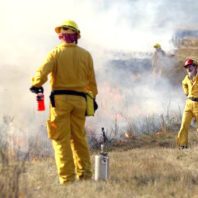
Ecological Responses to Conservation Tools
Endangered species are threatened by habitat loss, habitat degradation, habitat fragmentation, invasive species and climate change. Reversing species declines requires understanding the ecological responses to these threats and, importantly, in the context of conservation tools that we can use to recover the populations.
Fire is a  conservation tool to restore historic ecological processes for disturbance-dependent species, such as many of the prairie species in Oregon and Washington. Historically, in this region, native peoples used frequent fires across wide swaths of the landscape to encourage and farm prairie plants such as Camas (Camassia spp.), which is a nutritious plant with a potato-like root. Our work demonstrates that well-planned prescribed fire to burn a portion of the habitat in each burn event allows for acceptable levels of larval mortality balanced by substantial enhancement in habitat and butterfly fecundity (Schultz & Crone 1998). Moreover, fire enhances habitat such that it encourages ant-tending behaviors which lead to higher larval survivorship (Warchola et al. 2015). Current work in our lab includes spatial explicit individual based models which build on prior behavioral research (McIntire, Schultz & Crone 2007) to investigate source-sink dynamics created by fire processes (sink habitat when it burns, source habitat for a few years after a burn) to place the use of fire in a broader landscape context and help guide managers on how to plan efficient, effective fire strategies.
conservation tool to restore historic ecological processes for disturbance-dependent species, such as many of the prairie species in Oregon and Washington. Historically, in this region, native peoples used frequent fires across wide swaths of the landscape to encourage and farm prairie plants such as Camas (Camassia spp.), which is a nutritious plant with a potato-like root. Our work demonstrates that well-planned prescribed fire to burn a portion of the habitat in each burn event allows for acceptable levels of larval mortality balanced by substantial enhancement in habitat and butterfly fecundity (Schultz & Crone 1998). Moreover, fire enhances habitat such that it encourages ant-tending behaviors which lead to higher larval survivorship (Warchola et al. 2015). Current work in our lab includes spatial explicit individual based models which build on prior behavioral research (McIntire, Schultz & Crone 2007) to investigate source-sink dynamics created by fire processes (sink habitat when it burns, source habitat for a few years after a burn) to place the use of fire in a broader landscape context and help guide managers on how to plan efficient, effective fire strategies.
Invasive plant and animal species are one of the leading threats to biological diversity. Conservation strategies for such sites must control invasive species must while minimizing the impact of control methods on native species, especially threatened and endangered ones. Though fire is effective for managing woody invasives, fire and mechanical techniques have limited impact on herbaceous species that dominate numerous butterfly habitats across North America. For this purpose, herbicides are an increasingly popular option (Schultz, Russell and Wynn 2008). Work on our lab investigates non-target effects of grass-specific herbicides, much of which suggests focused applications have promise, but require appropriate monitoring within the context of species’ life histories to minimize risk to focal species (Russell & Schultz 2010; LaBar & Schultz 2012; Glaeser & Schultz 2014; Schultz et al. 2016).
Bonoan, R.B., E. E. Crone, C. B. Edwards and C. B. Schultz. 2021. Changes in phenology and abundance of an at-risk butterfly. Journal of Insect Conservation 25: 499-510
Schultz, C. B. and J. A. Ferguson. 2020. Demographic costs and benefits of herbicide-based restoration to enhance habitat for an endangered butterfly and a threatened plant. Restoration Ecology 28: 564-572.
Bennion, L. D., J. A. Ferguson, L. New and C. B. Schultz. 2020. Community-level effects of herbicide-based restoration treatments: Structural benefits but at what cost? Restoration Ecology 28: 553-563.
Thomas, C. C., C. V. Tillberg, and C. B. Schultz 2020. Facultative mutualism increases survival of an endangered ant-tended butterfly. Journal of Insect Conservation. 24: 385-395
Warchola, N., E. E. Crone, and C. B. Schultz. 2018. Balancing costs and benefits of fire for population viability of endangered butterflies. Journal of Applied Ecology 55:800-809.
Schultz, C. B., J. L. Zemaitis, C. C. Thomas, M. D. Bowers, and E. E. Crone. 2016. Non-target effects of grass-specific herbicides differ among species, chemicals and host plants in Euphydryas butterflies. Journal of Insect Conservation 20:867-877.
Warchola, N, C. Bastianelli, C. B. Schultz, and E. E. Crone. 2015. Fire increases ant-tending and survival of Fender’s blue butterfly larvae. Journal of Insect Conservation. 19:1063-1073.
Thomas, R. T. and C. B. Schultz. 2016. Resource selection in an endangered butterfly: Females select native nectar species. Journal of Wildlife Management 80:171-180.
Glaeser, R. and C. B. Schultz. 2014. Characterizing a contentious management tool: the effects of a grass-specific herbicide on the silvery blue butterfly. Journal of Insect Conservation 18:1047-1058.
LaBar, C.C. and C. B. Schultz. 2012. Investigating the role of herbicides in controlling invasive grasses in prairie habitats: Effects on non-target butterflies. Natural Areas Journal 32:177-189.
McIntire, E. J. B., C. B. Schultz, and E. E. Crone. 2007. Designing a network for butterfly habitat restoration: where individuals, populations and landscapes interact. Journal of Applied Ecology 44:725-736.
Russell, C. and C. B. Schultz. 2010. Effects of grass-specific herbicides on butterflies: an experimental investigation to advance conservation efforts. Journal of Insect Conservation 14:53-63.
Schultz, C. B. and E. E. Crone. 1998. Burning prairie to restore butterfly habitat: a modeling approach to management tradeoffs for the Fender’s blue. Restoration Ecology 6:244-252.
Schultz, C. B., J. L. Zemaitis, C. C. Thomas, M. D. Bowers, and E. E. Crone. 2016. Non-target effects of grass-specific herbicides differ among species, chemicals and hostplants in Euphydryas butterflies. Journal of Insect Conservation 20:867-877.
Warchola, N., C. Bastianelli, C. B. Schultz, and E. E.Crone. 2015. Fire increases ant-tending and survival of the Fender’s blue butterfly larvae. Journal of Insect Conservation 19:1063-1073.
Warchola, N., E. E. Crone, and C. B. Schultz. 2017. Balancing costs and benefits of fire for population viability of endangered butterflies. Journal of Applied Ecology. In press.